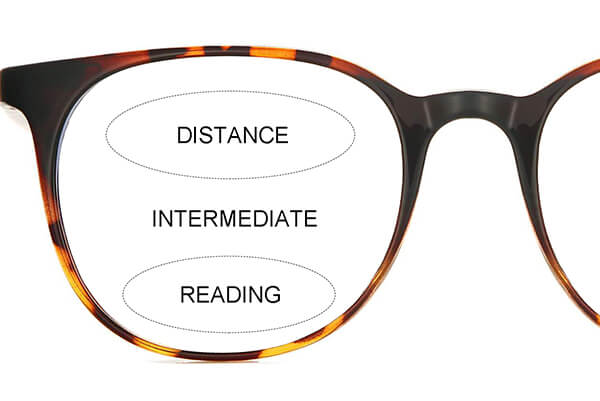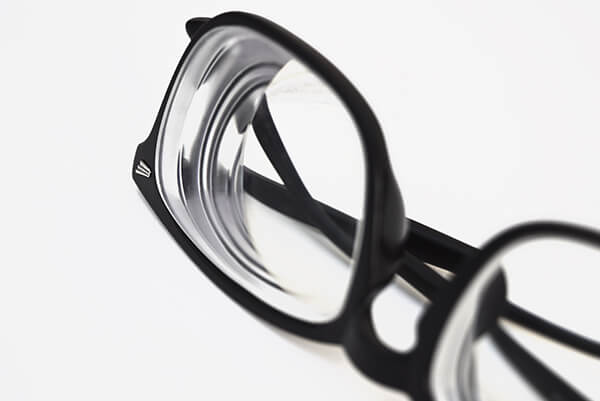The particular lens you choose for your glasses will usually determine how satisfied you are with the glasses. And buying spectacle lenses is not easy. There are too many choices of lens types and coatings, and most people do not know how to make a decision, and may be confused about this. A common mistake is people when buying glasses is that there is not enough time to consider lens materials, design and coatings.
This blog provides you with the basic knowledge you need when buying eyeglass lenses. I think that after reading this article, it will more or less help you eliminate your doubts about different types of spectacle lenses and help you choose the lenses and coatings that best meet your needs.

Lens advantages
Anti-scratch coating
The softest spectacle lens is also the most impact-resistant lens: polycarbonate. However, all plastic and high refractive index plastic lenses require factory-applied scratch-resistant coatings to ensure adequate lens durability. The anti-scratch lens is made by adding nanoparticles to the product, and it is a lens with a special coating. The scratch resistance of this lens is more than 10 times that of the uncoated lens. In case of scratches, ANRRI can replace it with a new one free of charge.
Anti-reflective coating
The anti-reflective coating is a very strong and thin film on the lens. The refractive index of the anti-reflective coating material is between air and glass. The coating we use has the effect of relieving eye fatigue. And reduce reflections and eliminate lens flare.
Anti-ultraviolet treatment
Anti-UV treatment. During a person’s lifetime, cumulative exposure to the sun’s harmful ultraviolet (UV) can cause age-related eye problems, such as cataracts and macular degeneration. Therefore, people should protect their eyes from ultraviolet rays. Fortunately, due to the absorption characteristics of the lens material, polycarbonate and almost all high refractive index plastic lenses have built-in 100% UV protection. Simply put, our lenses can block 100% of UVA and UVB rays.
Prescription type
Single-Vision Distance
If you wear distance correcting glasses, the prescription will start with (-), and the lens will be concave or curved inward to correct vision correctly. These lenses can correct near, middle or far vision. Moreover, this option is the option most people choose.
Multi-focus/progressive
Our progressive lenses provide seamless close and distance correction and all functions in between, so you don't need to switch between multiple pairs of glasses. Divided into 3 areas, long-distance use, gradual use and short-distance use. If your prescription drug has an "ADD" value, it is appropriate to use a progressive agent.
1. Distance Look straight ahead (height of sight) for activities such as watching TV and driving.
2. Intermediate is great for spending time on the computer. (It is best if the top of the monitor or laptop screen is below the line of sight.)
3. Reader For all close tasks (such as reading (of course) and paperwork), you need to raise your chin and lower your eyes.

Single-Vision Reading
Reading lenses are actually helping you to see things up close. These lenses are convex or curved outwards and are suitable for people with prescriptions beginning with (+). These lenses provide simple magnification and generally do not require reading prescriptions. Although single vision lenses are suitable for most glasses wearers, your eyes may be unique. If you have difficulty seeing clearly at both close and long distances, you may need dual focus or multi focus. These glasses can correct your vision at multiple distances, allowing you to see clearly at close and long distances.
Non-prescription drugs
Without vision correction, all the styles and protections of optical lenses can be obtained. There are blue light blocking glasses and ordinary non-blue light glasses. If there is no prescription number, no extra money is needed.
Lens type
classic
This is a white film without blue light-proof lenses. Scratch-resistant, impact-resistant, and block 100% of ultraviolet rays.
Blue light filter
Blue light is everywhere, wear anti-blue lenses to protect your eyes from the negative effects of mobile phones, computers and tablet screens.
Light response
Transition from transparent to special lenses for sunglasses. You have two colors to choose from, one is color-changing brown and the other is color-changing gray. Photosensitive lenses can be used in all prescription types, from monocular and progressive to over-the-counter drugs and readers. Under ultraviolet light (direct and indirect light), the photosensitive lens will begin to darken, and the darkness and transition speed depend on the ultraviolet radiation and temperature. Then after entering the room, the clarity (or close to clarity) is quickly restored. Almost all lens materials and designs can use photochromic lenses.
LENS MATERIALS
Refractive index
Myopia lens is a kind of concave lens, thin in the middle and thick in the periphery. The center thickness and peripheral thickness of different refractive index lenses are different. The refractive index of the lens is the ratio of the propagation speed of light in vacuum to the propagation speed of light in the lens material, and reflects the refractive power of the lens to light. Under the same premise, the higher the refractive index of the lens, the thinner and lighter the lens. So, how do you choose the refractive index of the lens according to your myopia? It is worth noting that as long as the refractive index of the lens is sufficient, choosing the right lens is not the higher the refractive index, the better.

1.61 Polycarbonate
This lightest, impact-resistant lens is our most popular choice. They are standard on all optical orders and are included in the price of our glasses. Suitable for use within +/- 2.00 degrees.
1.67 high index
Recommended for people with strong prescriptions. The degree of myopia is greater than +/- 300, but less than +/-600. The thickness of 1.67 high refractive index lenses is 20% thinner than polycarbonate lenses.
1.74 high index
If your focal power exceeds +/- 600, then there is no doubt that if you want to reduce the weight of the lens, then 1.74 is your best choice. Because as mentioned above, the higher the refractive index, the thinner the lens. Currently, the 1.74 high refractive index plastic lens on the market is the thinnest lens. This 1.74 lens requires additional customization. There is currently no 1.74 purchase link on the ANRRI website. Therefore, welcome to send us an email to consult us.
Which Type of Eyeglass Lens Is Best for Me?
When you have read this blog completely, I think you have understood the most basic knowledge of lenses. Vision is very important to your daily life, which is why you need a pair of glasses that are most suitable for you to optimize your vision.
But ANRRI still has the following tips:
Buying spectacle lenses may seem daunting, but it is not necessary. The key is to obtain accurate and unbiased spectacle lens information from trusted sources.
In order to make your glasses the most satisfactory, in addition to using this guide, you should also perform a professional eye examination and ask the ophthalmologist which spectacle lens and spectacle treatment method best suits your specific needs and spectacle prescription.







































